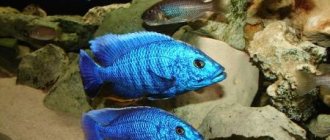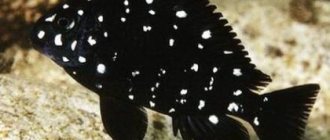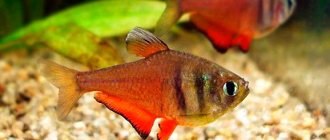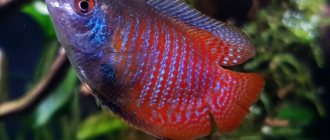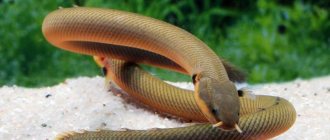Protomelas boadzulu (Haplochromis boadzulu, Protomelas taeniolatus, Red Empress Cichlid) is an aquarium fish of the genus Protomelas, belonging to the cichlid family. It has many different names, among which the most popular are red empress, tsirtokara boazulu, haplochromis boadzulu (old name).
In the wild, the fish reach a size of 15 cm, in an aquarium they are slightly smaller - 12 cm. They have no obvious sexual differences at a young age. Adults differ in size - females are not a couple of centimeters smaller than males and in color - in the male it is bright, rich, in the female it is pale, grayish, with a metallic tint (like all juveniles). Only the dominant male has a rich color; the rest are disguised as females.
R. Taeniolatus has a large number of color morphs - Chizumulu, chilumba, blue fire, boadzulu red, likoma, namalenje, red empress. Also popular among aquarists are such species of protomelas as P.spilonotus, Protomelas spec. "steveni taiwan" or "taiwan reef" and P.virgatus.
The lifespan of the Red Empress is approximately 5 years or more.
Content
Haplochromis is a predatory and moderately aggressive fish. You will need a 200 liter aquarium in which a male and several females are placed to prevent fights during the spawning period. Sandy soil and decorations simulating a rocky landscape are laid at the bottom. For the species Haplochromis jackson, gravel and pebbles can be laid out as a substrate.
The fish will need shelter in the form of grottoes and caves, but there should also be enough free space. Plants that are suitable are hard-leaved with strong roots. The water parameters are as follows: hardness 6-10, acidity 7.5-8.7, temperature 23-28°C. Requires filtration, regular quarter-water changes weekly, and aeration.
It is important to maintain the level of cleanliness of the aquarium and clean it of the remains of uneaten food and waste, which during the process of decay release ammonia that is harmful to the health of the fish.
Comfortable water parameters for keeping: 25-27°C, dH 8-20°, pH 7.5–8.5, aeration, filtration, weekly replacement of 1/3 of the water with fresh water.
Homeland - rocks near the island. Boadzulu.
The length of the fish in the aquarium reaches up to 12 cm.
Color: the body is shiny blue, especially in the front, the back half of the body with orange spots. The fins have gray-blue tones. The dorsal fin has an orange border.
The fish are relatively peaceful and can be kept in a community aquarium of 100 liters or more. (for a couple). Peaceful cichlids can be neighbors.
Appearance:
Up to 15 cm in size, 10-20 cm in an aquarium. The male is wine-red with numerous blue-violet sparkles, the gill covers are greenish-turquoise. The active male has a metallic blue head and nape area. Each scale on the back half of the body has an orange spot, so that the fish glow with fire in appropriate lighting. The fins are gray-blue, the dorsal fin has a whitish longitudinal stripe and an orange border. The male shows off his outfit by spreading his fins, dotted with red spots that imitate caviar.
Females are somewhat smaller, silver-pink with two longitudinal black stripes, pinkish fins. At the time of spawning, the female’s stripes are replaced by a transverse dotted line, and the color of the body resembles an old, clouded mirror. The main body color of juveniles is silvery-white. Of the 2 black longitudinal stripes, the upper one runs almost parallel to the lateral line up to the end of the dorsal fin, the lower one runs in the middle of the body from the posterior edge of the gill cover to the caudal peduncle.
Parameters: shape and volume
The cichlid must match the character of the fish, their temperament and lifestyle. The best form is a trough aquarium. The fish constantly furrow the bottom and move through stones and dig holes. This is due to the fact that cichlids are classified as territorial fish. Therefore, if there is insufficient bottom area, the fish will engage in constant skirmishes for territory. The volume of the aquarium depends on how large the breeds you plan to keep.
If the cichlid is stocked with medium-sized fish, then its volume should start from 200 liters. At the same time, it is recommended to place no more than 4 fish in an aquarium of this size. The cichlid should have an elongated shape. You should choose aquariums with a wall length of 90 cm or more. Thanks to this, the territory between the males will be divided in the most rational way.
MYTHS AND LEGENDS OF CICHLID FEEDING
Until now, there is fierce debate among aquarists about the diet of cichlids. Personally, I always adhere to the golden rule - the diet of any type of fish should be balanced.
Cichlids are predators. In addition to dry food, live food (bloodworms, brine shrimp, etc.) and freezing, they happily eat “food from our table.” Many aquarists recommend feeding cichlids (especially large troglodytes) shrimp, squid, chicken, lean meat, ox heart, fish, and even expensive cat food! However, the remark of other aquarists that such foods are not very well absorbed by fish and ultimately lead to cirrhosis of the liver (especially for meat and bovine heart) is appropriate here.
In addition, aquarists note that the protein content in bloodworms is an order of magnitude greater than in muscle meat
With such arguments, you involuntarily agree. After all, no one throws veal into the African rivers Tanganyika and Nyasa, much less cat food!
One conclusion can be drawn here: cichlids can be fed with the above-mentioned “meat” foods, but as a delicacy - rationally (for example, twice a week). Even the largest cichlid should not be transferred exclusively to minced meat. In addition, do not forget about plant nutrition, which many cichlids also respect.
There are many recipes on the Internet for “homemade mixes” for cichlids, which include protein and plant foods, and other necessary elements. Perhaps this is the best option for feeding “from our table”.
As for plant food for cichlids, everything is much simpler. It is best to feed them inexpensive aquarium plants or to specially grow duckweed separately. You can also give scalded lettuce leaves, spinach, green peas, etc.
Breeding
Breeding haplochromis in captivity is a rather difficult process, which is best organized in a separate container at least 1 meter in length. Flat stones are placed in the aquarium and Vallisneria is planted. The temperature is raised by 2 degrees, acidity to 8.5. The fish are placed in advance and fed with high-quality live food.
For successful reproduction, three females are combined for one male, since males become conflicting. Females ready for reproduction are the first to approach the male, after which he fertilizes the eggs. The females take the eggs and hatch them in their mouths for 3 weeks. The fry are born with a fully formed appearance, grow very quickly, and feed on live dust and artemia nauplii. Sexual maturity is reached at 12 months.
Many species of Haplochromis can interbreed with other species or some cichlids: the golden leopard is combined with Haplochromis livingston and the blue dolphin, the long-snouted with Boazulu and Borleya. But for the purity of the species, it is recommended to keep haplochromis in a species aquarium.
Nutrition:
The food should consist of 80% animal and 20% plant components. The basis of nutrition is live and frozen bloodworms, large crustaceans (daphnia, adult brine shrimp), scraped meat, and seafood. The species is susceptible to toxicosis, especially food toxicosis (you must be especially careful when feeding tubifex).
Nutrition
In nature, they feed on zooplankton in the water column. In a home aquarium, it is necessary to provide an appropriate diet consisting of small invertebrates, for example, brine shrimp, bloodworms, and daphnia. A good choice would be food intended for Utaka cichlids, produced by many manufacturers.
Our product Aqvium natural dry food for small and medium fish from clean lakes of Siberia and Northern Crimea in environmentally friendly biodegradable packaging.
Find out more
Compatibility
Haplochromis can be kept together with relatives of different species and other peaceful cichlids. It is not recommended to add small fish or large predators to them. The most aggressive are Haplochromis Livingston and Haplochromis Jackson. These types of fish can get along with cichlids of the mbuna group with a peaceful disposition.
And the more peaceful species include: haplochromis boazulu, golden leopard, obliquidens, haplochromis long-snouted. Despite their loyalty, these fish will not allow themselves to be offended and can certainly show aggression during the spawning period.
The Haplochromis fish is an interesting specimen among other representatives of cichlids due to its external characteristics and special behavior. But at present, it is almost impossible to find pure species of Haplochromis in pet stores, so it is not recommended to cross these fish.
Habitat
Haplochromis Boadzulu is a fish of the cichlid family, which has an amazing appearance and unusual color . Its homeland is African lakes, in particular the reservoirs of Malawi and Boazulu (where one of the names came from).
We recommend that you familiarize yourself with the different types and characteristics of keeping cichlids, in particular with the Malawian cichlids and the representative of African cichlids - Labidochromis yellow.
The natural habitat of fish is rocky biotopes. They prefer to huddle on a sandy bottom, near rocky underwater cliffs. The most comfortable living depth is below 10 m.
Males and females flock together in flocks of 10 individuals. Males always limit their territory and show aggression towards others during the breeding season.
Reproduction of handsome chromis
Handsome chromis are monogamous; as soon as they choose a mate for reproduction, they will spawn only with her. The problem is to find a female for spawning (and it is difficult to distinguish her from a male), and one that will suit the male, otherwise they can kill each other. They are very aggressive with each other if the match does not suit them
The first time you introduce them to each other, it is very important to monitor how they behave. If you are not careful, one of the fish can be found with torn fins, wounded or killed
If the couple gets together, then the male is preparing for spawning and his coloring greatly intensifies. In this case, you need to monitor the female; if she is not ready for spawning, the male can kill her.
The female lays up to 500 eggs on a smooth, pre-cleaned surface. Sometimes this may be inside the pot, but more often it is a flat, smooth rock. The larva hatches after two days, and the parents take great care of it. The female collects them and hides them in another place until they consume the contents of their yolk sac and swim. This will occur approximately three days after the larvae emerge. The male will guard the fry and create a perimeter in the aquarium that no fish can cross. However, the female will also not lag behind him. Chromis fry are fed on Artemia naupilia, but they grow very unevenly and eat each other. They need to be sorted. The parents will look after the fry until they are about a centimeter long, and then leave them.
All of the above is just the fruit of observing this type of aquarium fish and collecting various information from owners and breeders. We would like to share with visitors not only information, but also live emotions that allow us to understand the world of aquariums more fully and subtly. Register at https://fanfishka.ru/forum/, participate in discussions on the forum, create profile topics where you will talk about your pets in the first person and from the horse’s mouth, describe their habits, behavior and content, and share with us your successes and joys, share your experiences and learn from the experiences of others. We are interested in every bit of your experience, every second of your joy, every awareness of a mistake, which makes it possible for your comrades to avoid the same mistake. The more of us there are, the more pure and transparent drops of goodness there are in the life and everyday life of our seven billion society.
Fish diseases
Unsuitable conditions make the fish susceptible to most common diseases, but in a balanced aquarium ecosystem, on the contrary, no health problems are observed. An unbalanced or monotonous diet often leads to the disease “Malawi Bloat,” which affects mainly representatives of the lake of the same name. Read more about symptoms and treatment methods in the section “Diseases of aquarium fish”.
Peculiarities
- Harem content
- Males are intolerant of each other
Reproduction of Flamingo cichlazoma
At the age of 9-10 months, the fish becomes a sexually mature individual. Only after this it becomes possible to determine their gender and this is very simple to do. They differ from each other in color and size. Male flamingos are more powerful and larger with a large frontal part. Females are smaller in size and have the most saturated colors with bright, reddish and blurry spots on the sides. During the breeding season, which lasts the entire spring-summer period, the female can lay eggs more than once.
After a few days, the fry hatch, the females themselves take care of their offspring, and the males protect the territory from the encroachments of other fish and can even attack the net or beat their neighbors to death. When the fry grow up, it is advisable to catch the parents and transfer them to another aquarium, otherwise they may eat their young. But if suddenly this happens, do not despair, the female will soon lay eggs again.
The captured fry should be placed in a smaller aquarium, approximately 30 liters of volume, and a slight air exchange should be established there. The water temperature should not be cool, it is best to make it 26-30 degrees. Starting from the third day, they need to be fed with ciliates, soaked oatmeal or special food. Even beginners can breed flamingos.
